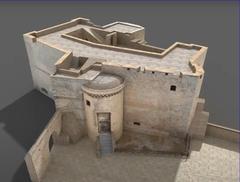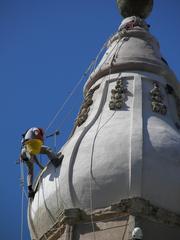Church of Santa Teresa, Monopoli, Italy: Visiting Hours, Tickets, and Historical Significance
Date: 14/06/2025
Introduction
Nestled within the heart of Monopoli’s historic center, the Church of Santa Teresa (Chiesa di Santa Teresa) is a remarkable testament to Baroque architecture and Carmelite spirituality. Situated in Piazza Palmieri, this 17th- to 18th-century monument offers a window into the city’s rich religious and cultural heritage. With its intricately ornamented limestone façade, lavish interiors, and enduring spiritual role, the church stands as a cherished destination for both locals and visitors seeking to immerse themselves in Puglia’s history.
This guide is designed to provide comprehensive information for travelers—including practical details on visiting hours, ticketing, accessibility, nearby attractions, and cultural highlights—while also exploring the church’s architectural features, historical context, and enduring community significance. For further resources and real-time updates, consult the Monopoli Tourism website and other recommended guides (Carnets Voyages, Beautiful Puglia, To Monopoli).
Historical Background
The Church of Santa Teresa was built under the patronage of the Carmelite order during the Counter-Reformation. It was conceived both as a place of worship for the local community and as a spiritual center for the Carmelite nuns in the adjacent convent. Its position in Piazza Palmieri, close to other aristocratic and religious landmarks, highlights the role of religious orders in shaping Monopoli’s civic and cultural landscape throughout the 17th and 18th centuries.
The church’s dedication to Saint Teresa of Ávila reflects the Carmelite emphasis on contemplation and reform, and its ongoing liturgical calendar preserves traditions that have been woven into the fabric of local devotion for centuries.
Architectural Highlights
Exterior
- Façade: Crafted from warm local limestone, the façade is a striking example of late Baroque style, featuring a central portal flanked by pilasters, decorative volutes, and an elegant pediment. Niches and cornices enhance its layered appearance, while a large central window bathes the nave in natural light.
- Bell Gable: Instead of a tall bell tower, the church features a modest bell gable integrated into the façade, in line with Carmelite architectural restraint.
Interior
- Nave & Chapels: The single-nave design creates an intimate worship space, with side chapels dedicated to various saints and Marian devotions.
- Ceiling & Sanctuary: A barrel-vaulted ceiling, often adorned with stucco and frescoes depicting episodes from the life of Saint Teresa, draws the eye toward the richly decorated high altar. The altar itself is a masterwork of polychrome marble, gilded wood, and Solomonic columns, centering on an altarpiece of Saint Teresa.
- Artistic Details: The church’s interior features intricate stucco work, local frescoes, and a harmonious blend of Baroque opulence and spiritual symbolism.
Religious and Cultural Significance
Carmelite Spirituality
Santa Teresa Church embodies the contemplative values and Marian devotion of the Discalced Carmelites, serving as a center for spiritual renewal and mystical theology. The church’s dedication to Saint Teresa of Ávila highlights its role in the city’s spiritual life, complementing Monopoli’s larger religious festivals and processions.
Community Role
The church continues to be an active place of worship and a vibrant participant in Monopoli’s religious calendar, including processions and feast day celebrations. Its integration with local traditions ensures the continuation of Carmelite heritage and fosters a strong sense of community identity (To Monopoli).
Visiting Information
Location and Access
The Church of Santa Teresa is centrally located in Piazza Palmieri, easily accessible on foot from Monopoli’s main train station (about a 15-minute walk). Local buses service the area, and public parking is available outside the historic center due to ZTL (limited traffic) restrictions (Carnets Voyages).
Visiting Hours
- General Hours: Typically open Tuesday to Sunday, 9:00 AM–12:30 PM and 4:00 PM–7:00 PM; closed on Mondays and major public holidays.
- Alternative Schedules: Some guides note hours as 8:00 AM–1:30 PM and 4:30 PM–7:00 PM, or, during festivals and Sundays, 8:00 AM–12:30 PM and 5:00 PM–7:30 PM. Always consult local signage or tourism resources for the latest updates.
Ticket Information
- Admission: Free entry; donations are welcome to support preservation.
Guided Tours
- Availability: Tours can be arranged via the Monopoli Tourism Office or local guides, often bundled with visits to nearby sites like Palazzo Palmieri.
Accessibility
- Mobility: The entrance features a small step, and the interior is on a single floor. While there is no dedicated ramp, assistance may be provided. Please contact local tourism services in advance for specific needs.
Visitor Experience
Atmosphere
Expect a serene and contemplative environment, especially during morning and early evening hours. The natural light enhances the stucco and marble details, making photography particularly rewarding.
Dress Code and Etiquette
- Respectful attire is required (shoulders and knees covered).
- Silence is appreciated, especially during services.
- Photography is generally permitted without flash, but discretion is encouraged.
Practical Tips
- Visit during daylight for optimal lighting.
- Explore nearby cafés and shops around Piazza Palmieri.
- Check for special events or festivals, such as the PhEST photography festival, which may include the church in combined tickets (Carnets Voyages).
Nearby Attractions
- Palazzo Palmieri: Adjacent Renaissance palace, reflecting Monopoli’s aristocratic history.
- Church of Santi Pietro e Paolo & Basilica della Madonna della Madia: Other significant religious sites within walking distance.
- Monopoli Old Town: Wander the charming alleys, markets, and seafront for a complete cultural experience.
Preservation and Contemporary Role
Restoration initiatives have preserved both the church’s structural and artistic integrity, ensuring it remains a vibrant landmark and a focal point for both worship and tourism (Beautiful Puglia).
Frequently Asked Questions (FAQ)
Q: What are the visiting hours?
A: Generally Tuesday–Sunday, 9:00 AM–12:30 PM and 4:00 PM–7:00 PM, but check locally for seasonal variations.
Q: Is there an entrance fee?
A: No, entry is free; donations are appreciated.
Q: Are guided tours available?
A: Yes, via the tourism office or local guides; booking in advance is recommended.
Q: Is the church accessible for visitors with disabilities?
A: The entrance has a small step and no ramp, but the interior is flat. Contact local services for assistance.
Q: Can I take photographs inside?
A: Yes, but be respectful, especially during religious functions.
Visuals and Interactive Media
Virtual tours and high-resolution images are available on the Monopoli Tourism website and Monopoli Virtual Tour, providing immersive insights before your visit.
Example alt tags for images:
- “Baroque façade of Church of Santa Teresa in Monopoli”
- “Interior altar artwork in Church of Santa Teresa”
- “Piazza Palmieri with Church of Santa Teresa and Palazzo Palmieri”
Additional Resources
- Monopoli Tourism Office
- Carnets Voyages
- Beautiful Puglia
- To Monopoli
- London City Calling’s Monopoli guide
- World Wanderista
Conclusion
The Church of Santa Teresa in Monopoli is a quintessential example of southern Italy’s Baroque artistry and spiritual depth. Its accessible location, free entry, and preserved beauty make it a must-see for anyone exploring Monopoli’s historical sites. By participating in guided tours, attending Mass, or simply admiring its architecture, visitors deepen their understanding of Puglia’s religious and cultural legacy.
For the latest information on visiting hours, events, and tours, consult official tourism channels, and consider using the Audiala app for personalized itineraries and audio guides. Share your experiences online to inspire fellow travelers, and enjoy discovering this Baroque gem in the heart of Monopoli.
Sources




